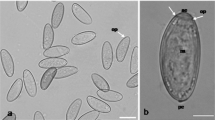Abstract
The calcium carbonate concentrations in the shells of Helisoma trivolvis and Physa sp. naturally infected with larval trematodes and Biomphalaria glabrata experimentally infected with larval trematodes were analyzed quantitatively. The larval trematode-snail relationships studied were H. trivolvis infected with larval Echinostoma trivolvis and Physa sp. infected with various larval digeneans, and B. glabrata infected with Echinostoma caproni or Schistosoma mansoni. The calcium carbonate concentrations of the shells of infected snails and uninfected cohorts and of the water in which the snails were maintained were determined by ion exchange chromatography. No significant differences in the calcium carbonate concentrations of shells of infected versus uninfected snails were found. The shells of B. glabrata infected with E. caproni contained significantly less calcium carbonate than the shells of uninfected B. glabrata. The hypercalcification hypothesis, i.e., larval trematodes induce an increase in the calcium concentrations in the shells of their snail hosts, was not upheld in any of the snail-larval digenean systems studied herein.
Similar content being viewed by others
References
Cheng TC (1971) Enhanced growth as a manifestation of parasitism and shell deposition in parasitized molluscs. In: Cheng T (ed) Aspects of the biology of symbiosis. University Press, Baltimore, Md., pp 103–137
Fried B, Muller EE, Broadway A, Sherma J (2001) Effects of diet on the development of Schistosoma mansoni in Biomphalaria glabrata and on the neutral lipid content of the digestive gland-gonad complex of the snail. J Parasitol 87:223–255
Hare PE, Abelson PH (1965) Amino acid composition of some calcified proteins. Carnegie Inst Wash Yearb 64:223–232
Idris N, Fried B (1996) Development, hatching, and infectivity of Echinostoma caproni (Trematoda) eggs, and histologic and histochemical observations on the miracidia. Parasitol Res 82:136–142
Kenkel J (2003) Analytical chemistry for technicians, 3rd edn. Lewis, Boca Raton, Fla., p 123
Malek EA, Cheng TC (1974) Medical and economic malacology. Academic Press, New York, p 398
Marxen JC, Becker W, Finke D, Hasse B, Epple M (2003) Early mineralization in Biomphalaria glabrata: microscopic and structural results. J Molluscan Stud 69:113–121
McClelland G, Bourns TKR (1969) Effects of Trichobilharzia ocellata on growth, reproduction and survival of Lymnaea stagnalis. Exp Parasitol 24:137–146
Pinheiro J, Amato S (1995) Calcium determination in the shell of Lymnaea columella (Mollusca, Gastropoda) infected with Fasciola hepatica (Platyhelminthes, Digenea). Arq Biol Tecnol 38:761–767
Ponder EL, Fried B, Sherma J (2004) Free-pool amino acids in Biomphalaria glabrata infected with Echinostoma caproni as determined by thin-layer chromatography. J Parasitol 90:665–666
Schell SC (1985) Handbook of trematodes of North America, north of Mexico. University Press of Idaho, Moscow
Schmidt KA, Fried B (1997) Prevalence of larval trematodes in Helisoma trivolvis (Gastropoda) from a farm pond in Northampton County, Pennsylvania with special emphasis on Echinostoma trivolvis (Trematoda) cercariae. J Helminthol Soc Wash 64:157–159
Sluiters JF, Brussaard-Wust C, Meuleman EA (1980) The relationship between miracidial dose, production of cercariae and reproductive activity of the host in the combination Trichobilharzia ocellata and Lymnaea stagnalis. Z Parasitenk 63:13–26
Thompson SN (1997) Physiology and biochemistry of snail-larval trematode relationships. In: Fried B, Gracyk TK (ed) Advances in trematode biology. CRC Press, Boca Raton, Fla., pp 149–195
Ulmer MJ (1970) Notes on rearing of snails in the laboratory. In: MacInnis AJ, Voge M (eds) Experiments and techniques in parasitology. Freeman, San Francisco, Calif., pp 143–144
Żbikowska E (2003) The effect of Digenea larvae on calcium content of the shells of Lymnaea stagnalis (L.) individuals. J Parasitol 89:76–79
Acknowledgements
We thank Dr. Jane E. Huffman and Ms. Jennifer L. Klockars, Department of Biological Sciences, East Stroudsburg University, East Stroudsburg, Pa. for providing us with Helisoma trivolvis and Physa sp. snails. We also thank Ms. Sharon R. Bandstra for help in preparing this manuscript.
Author information
Authors and Affiliations
Corresponding author
Rights and permissions
About this article
Cite this article
White, M.M., Chejlava, M., Fried, B. et al. Effects of various larval digeneans on the calcium carbonate content of the shells of Helisoma trivolvis, Biomphalaria glabrata, and Physa sp.. Parasitol Res 95, 252–255 (2005). https://doi.org/10.1007/s00436-004-1279-1
Received:
Accepted:
Published:
Issue Date:
DOI: https://doi.org/10.1007/s00436-004-1279-1




